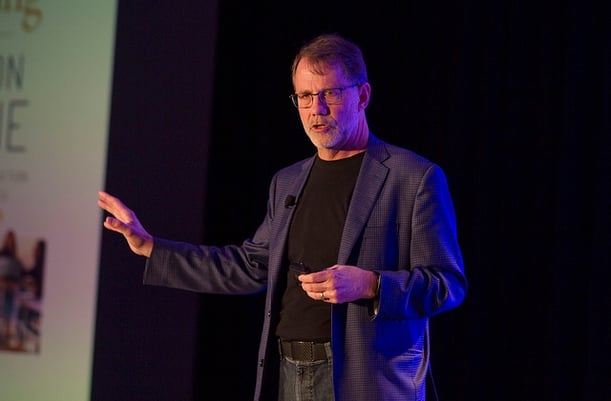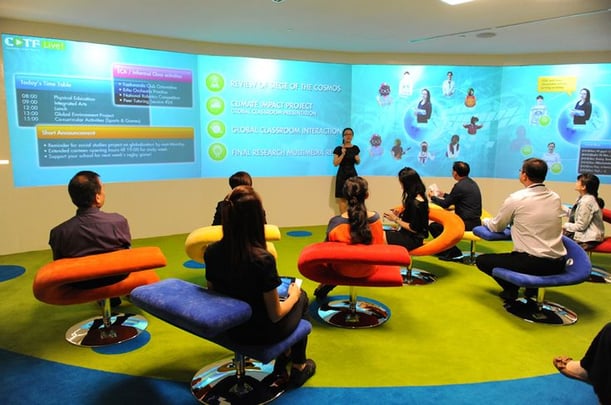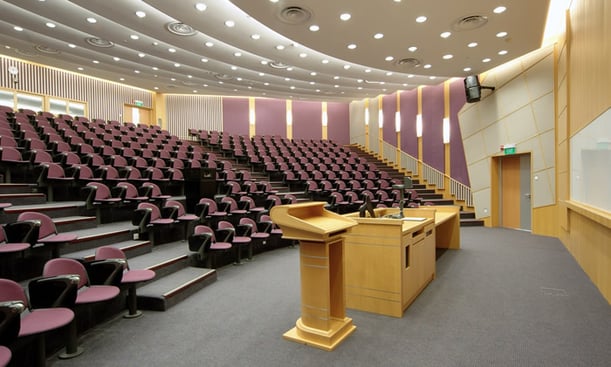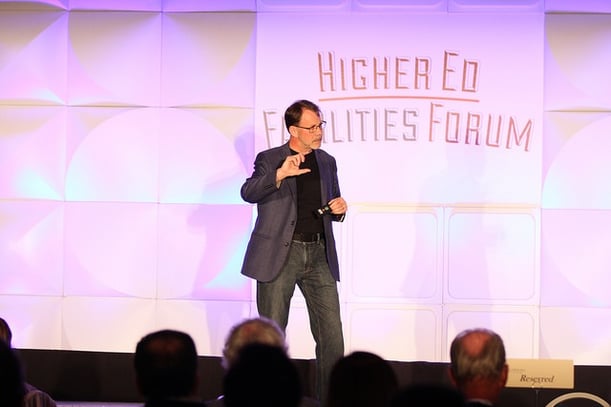We’re facing an existential crossroads in education--and it’s serious enough to affect our nation’s security and prosperity, according to Rex Miller.
At the Higher Ed Facilities Forum, the futurist, author and principal of MindShift led a dynamic discussion on how facilities leaders can spearhead change in higher ed, the change desperately needed for universities to thrive.
The building has a voice in the learning environment: it sets the tone to either enable or constrain the teacher and student experience. Miller’s challenge for facilities leaders? To step into a new role: throw away the templates, break down the silos, put the student at the center, and reconnect to what learning is really like today.

The Problems in Today’s System
For over two years, Miller’s team of more than 100 experts traveled the country exploring the challenges in preparing all kids for success when they leave universities. What they found is a broken system: a model of education that was relevant 300 years ago...not so much in 2017.
This research showed that education is a “one-size-fits-all machine,” setting up 50% of kids to do well and 50% to be left behind due to socioeconomic differences and different learning styles. Other challenges facing Higher Ed? It’s no short list: Reduced funding, political scrutiny, recruiting talent, shifting social norms, unprepared freshmen, and graduation rates are just a few. When surveying the audience, reduced capital budgets were found to be a deeply troubling issue for facilities departments across the nation.
“It’s a melting iceberg, but jumping to another iceberg won’t help."
"We need to learn how to swim. The institution of education birthed in the Gutenberg revolution is over,” Miller said.
To prepare students for the future, what we need is new pedagogy, new tools and new environments. More importantly, we need a new mindset. In his book “Humanizing the Education Machine: Turning Disengaged Students into Inspired Learners,” Miller found numerous inspiring stories of schools and their stakeholders reimagining what learning needs to be and can become.
Here are the key takeaways from these common principles and practices:
#1- Facilities Leaders Have an Opportunity to Lead Change.
Isn’t the job of the facilities departments just to build better, faster, and cheaper?
Not even close, said Miller, who believes that facilities have a bigger mission with a unique vantage point at the very center of the university’s issues.
“Facilities are the only group that sees all the parts of the institution come together in one piece, and its the facility: you deal with all the politics, pedagogy, the IT, the users. If we can’t amp it up, we’re missing the boat.”
To “amp it up,” we must understand what the learning experience is for students in the 21st century. Which leads Miller to his next important point...
#2- Engage with Students.
Research shows that 70% of people would rather be anyplace then work or school. Clearly, there’s a disconnect that can’t be solved without asking students what the experience is like and should be like. This feedback is invaluable.
#3- Define Your Values and Create a Positive Culture.
Miller’s team traveled to the most engaging organizations in the world to figure out their philosophy and strategy toward the built environment. They found that the building is a proxy for value.
“Values are simply what you think is important, while culture is what happens when you’re not there. What happens when you’re not around to direct, troubleshoot, or supervise?” Miller said.
“Since culture is a collection of behaviors that happen over and over again, you need to get a handle on disrupting these behaviors that are detrimental to your goal.”
#4- Embrace the Golden Triad.
Why is it that teams are so important in the workplace, but are seen as “cheating” in schools?
The opportunity for change is a collaboration between the teacher, classroom, and technology.
Miller calls this “the golden triad.” Change starts with the teacher-student relationship-- this then triggers change in the methods, tools, and environment. Any part that isn’t changing becomes a bottleneck.
Microenvironments are a great way to harvest back spaces in schools that are underutilized. Hallways, entryways, cafeterias: facilities leaders need to look at all areas as potential learning environments.

#5- Don’t end up on the wrong side of Moore’s Law.
Would you rather have a million dollars tonight, or a penny doubled for 31 days? The immediate reward is obviously tempting. But the sucker punch (as you’ve probably assumed) is that the penny is compounding, and you don’t see it until Day 29.
2007 was day 29 for Nokia, Blackberry, and Motorola--and it was too late. They never saw it coming because every year, “they were just doing the same thing a little better.” But in tech, there are inflection points that change the game completely. The Internet of Things and personalization of education is coming, and they absolutely must be on a university’s radar.
No one avoids Moore’s Law; it’s just that all the bureaucracies, rules, and funding in Higher Ed have made this change slower to hit.
“Other things are coming that provide more value: Higher Ed needs a new value proposition,” Miller said. “Blockbuster and Kodak didn’t see it coming. Failing to adapt means your university will be first to fall.”

90% of provosts think grads are ready for working world compared to 11% of CEOs. This deep disconnect comes from not preparing students for a Google world. In a mobile/social world...how many classrooms truly leverage the smartphone?
Learning has shifted from content memorization to navigation: knowledge is now being aggregated a different way, and rising student debt has also changed the game and increased pressure on universities.
#6-Design to enhance social capital.
When you have a professor at the front of the room, it signals: "This is the smartest person in the room." But...he’s not smarter than the whole room together. He becomes the bottleneck to their learning.

“All these relationships and connection points exist, so if he were to just frame great questions that would drive people to learn the content through team dynamics and problem solving, they’d walk away with a lot more value and experience, plus social capital,” he said.
How can we “rehumanize the machine”?
“We can’t keep doing one size fits all. We’re teaching kids how to game the system; in SAT prep, strategies are taught for "guessing" the right answer. What’s the logical consequence of that? Its Volkswagen,” Miller said.
The end result is disengagement. The machine takes the care and soul out of learning, and we need to rehumanize it because the truth is that we all intrinsically love learning. When you ask people what they’d like to learn, they light up--it’s in the face of dry, one-sided lectures that they wilt.

“When we can begin to look at what the learning experience is like, we can begin to create and partner with the people providing that, and build environments where learning is fun, joyful, engaging and productive,” Miller said.
“To enable learning, you need to build bridges to the academic side. That’s part of your new role and vision,” Miller said. “If all you are is an extension of budgets and schedules, you’ll be out of business soon. It’s happening in the corporate world, with services becoming rapidly outsourced.”
The value lies in social capital, and building relationships and alliances within your institutions to do good work.
Miller’s Action Plan for Leading Change:
-Look with fresh eyes and ask questions that challenge assumptions.
-Experiment with others who are interested and committed to change.
-Brand your effort: name it, have a story to tell.
-Prototype with an early adopter and champion other early adopters.
-Showcase your learning and educate others on your mission.
“When you show how it can be done better, then you have a value and can use design and space as a catalyst for new experiences,” Miller concluded. “Facilities leaders are in the business of creating learning experiences, and it’s essential to get reconnected to that experience.”
For more on the future of Higher Ed learning, check out Miller's full talk:

Posted by
Join us at HEFF!
An interactive retreat for facilities leaders at the nation's top colleges and universities.
Nov 8-10, 2026 | San Antonio, TX
Learn More









Comments